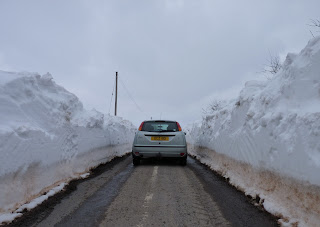A year ago I was still very much under the bleak cloud of the illness, very afraid I'd have to go back into hospital for more surgery. In January I was told this wouldnt be necessary and I walked forward with a spring in my step for the first time for a year and a half.
Sadly, Jean, a very close friend for 30 years, had the opposite news. Her cancer came back aggresively and she died in April. At that time I was also helping a group of cancer survivors from the Sing for Life Choir prepare for the Belfast Marathon Walk. All completed the 9 mile walk successfully and we raised £2500 for Cancer Focus. I continued singing with the choir (the earliest of my new activities) and have learned to sing better, or at least to make fewer mistakes.
During the Spring I began to write poetry again, for the first time since my illness. I challenged myself to write new poems around words chosen at random from the OED. This was stimulating and very productive. I also noticed that I seemed to be writing in a different style.
Indeed, this was true of many of the activities I picked up again. The illness had been a watershed and I wasnt (indeed couldnt be) the same afterwards. Like Humpty Dumpty I'd had a great fall, and painfully and painstakingly I'd been put back together. But the pieces didnt quite fit like they had before: some parts of me (and my life) were now more important and others had diminished in significance.
For the two year anniversary of my 'big op' I rented a motorbike and went on a tour of the northern half of this island. The weather was great and the touring was good, once I got used to the motorbike: my old skills, unused for 30 years, came back. But I couldnt help envying the cyclists I passed as I sweltered under the sun in my all black bike kit.
The longest day found me on holiday in Shetland, my first real trip away since my illness. A great place for wildlife and costal walks. The evening light was fantastic, indeed it hardly gets dark - its called the Simmer Dim.
On my return I decided to try cycling again. At first I was tentative and managed small trips along the towpath at Scarva, then I got bolder. Before long I was doing the whole trip, some 40 miles. It was great to feel the wind on my face and through my receding hair. During my illness and recovery I thought I'd never be able to cycle again.
In the Autumn I joined a birdwatching group and went on field trips around NI and to Donegal learning much from the very knowledgeable Ivor. With Ray Givans from the Writer's Group, I began another new venture - a poetry night with a difference called The Squat Pen.
Lately, I extended my regular walking through Tolleymore and Castlewellan Forest Parks to actual hillwalks in the Mournes. Like cycling, this was another old activity I feared I would not be able to do again. But over the Xmas holidays I've climbed four mountains and managed each well.
Finally and most importantly of all, I've begun a new relationship. I met T during the Summer and we quickly became close. Since then its got better and better. We are undoubtedly an item. We begin the New Year together with a trip to a hotel in the far West of Ireland.





























